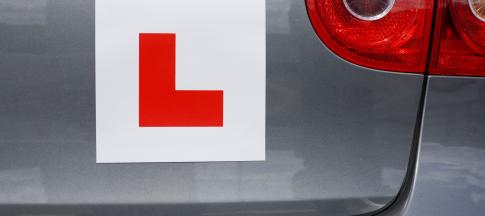The motorway: two words that can strike fear into the heart of many an inexperienced driver

It's understandable that new drivers get nervous of motorway driving.
They're some of our fastest, busiest roads, and travelling at these speeds can be nerve-wracking - especially if you're in a smaller car and find yourself surrounded by heavy goods vehicles.
So how do we make learner drivers more comfortable with the idea of motorways? Perhaps letting them drive on them while they learn would be a good start...
Can learner drivers drive on motorways?
From 4 June, 2018, learner drivers have been allowed on motorways with an approved driving instructor. Before then, it was only possible to have motorway lessons after you’d passed your driving test.
Learners can get experience of motorways with their driving instructor.
RAC Foundation director, Steve Gooding, shone a little light on the changes: "The casualty statistics tell us motorways are our safest roads, but they can feel anything but safe to a newly-qualified driver. Many are so intimidated by the motorway environment they choose instead to use statistically more dangerous roads," he said.
It's unclear how learners in some parts of the country would be affected by these changes, as the UK's motorway network does not extend into many parts of Wales, northern Scotland, East Anglia, the East Midlands, Northumberland, or Cornwall.
Jimmy Ho, an approved driving instructor from Diamond Advanced Motorists, gave his opinion on the changes.
"I believe that for too many years the driving test has been a test based on exercises that don't really reflect real life driving," he said.
"Motorway lessons should be compulsory rather than voluntary. All learner drivers should have the training and experience to drive on different types of roads, and it makes no sense that people can choose whether to reduce their risk of accidents or not."
What is motorway driving like?
Motorway driving is typically very safe. The lanes are wide and fairly straight, and there aren't any pedestrians to worry about.
You still need to have your wits about you, though, and should check your mirrors regularly for other drivers approaching from the side or rear.
Joining the motorway
When driving down the slip-road, get up to speed as quickly as you can, bearing in mind there may be traffic at a standstill on the motorway. If the traffic is flowing freely, merge into the inside lane, making sure to signal and check your blind spot for anyone already in the lane.
Counterintuitively, the inside lane isn't the one at the middle of the carriageway (where the central reservation is), but the one closest to the hard shoulder. If you're feeling nervous, stick to this lane.
When passing an entry slip-road, you may want to move into the middle lane to create a space for drivers entering the motorway as they get up to speed. Once you've overtaken them, you can move back into the inside lane.
Overtaking
You can use the middle lane, and in turn the outside lane, to overtake people.
Remember, the speed limit is the same for everyone on the motorway, even when overtaking: 70mph. When you're overtaking on the motorway, you should always overtake to the right.
Some drivers can get irritated by so-called 'middle lane hogs', who force people into the outside lane to overtake. Not only will you irritate other drivers, but it's actually an offence that can earn you three points on your licence and a £100 fine.
So if you're not overtaking someone, move left to let other drivers past.
Maintaining a safe distance
Leave a good gap between you and the car in front. Some motorways have chevrons painted onto them to help you with spacing - you should aim to leave a gap of two chevrons.
If someone is hogging the middle lane and won't pull left to let you past, be patient. Tailgating is illegal. Flashing your lights is bad road manners and can distract the driver from moving across safely.
Look out for upcoming hills and be prepared to change into a lower gear to keep up your speed. Be aware that some larger vehicles, especially lorries and coaches, can struggle to maintain their speed on hills, so be prepared to react and apply the brakes if needs be.
Staying alert
On long motorway treks, the monotony of the journey can take its toll on your ability to concentrate. Take a good 15-minute break at least every two hours or so by pulling into a service station, stretching your legs and grabbing a coffee.
Exiting the motorway
Plan your journey ahead and make a mental note of the junction number you need. The upcoming junctions should be well sign-posted, so be ready to move across into the correct lane. There are countdown markers telling you how far it is until the slip-road; three bars is 300 yards, two bars is 200 yards, and so on.


